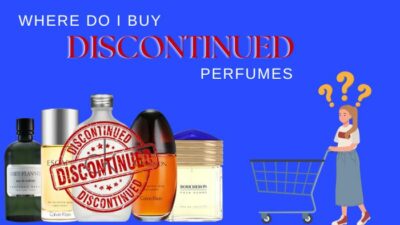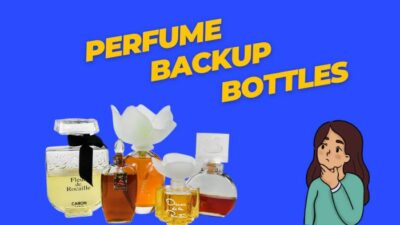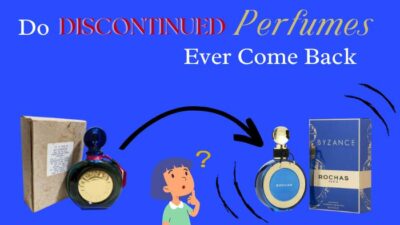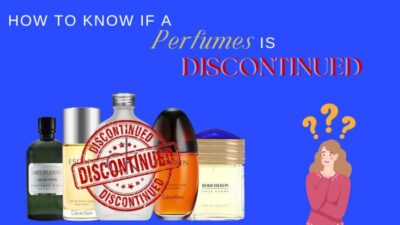Sometimes we come across an aura that makes our senses wild and captivates our souls with its intoxicating charm. The flower with the golden petals Ylang-Ylang will evoke the same feeling in you.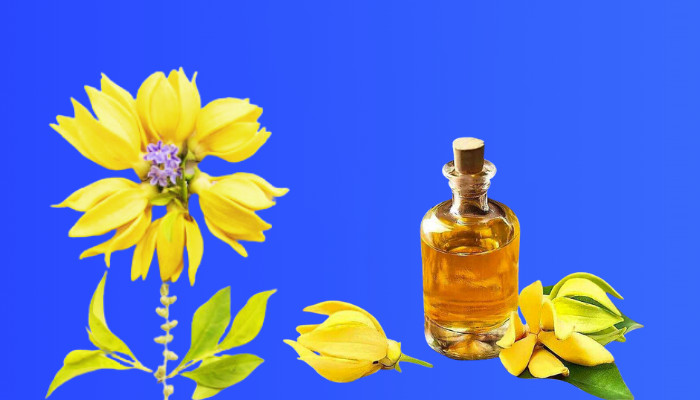
But have you ever wondered where it comes from, how it smells, and what other unique facets this floral queen has?
Well, no worries, in this article I’ll delve into the world of ylang-ylang, exploring its unique aroma, its presence in perfumery, and some amazing benefits
So, let’s get started!
What Is Ylang-Ylang?
Ylang-Ylang is a star-shaped, yellow-colored flower with long curved petals that grows in the trees named Cananga. The scientific name for the tree is Cananga odorata which is a name derived from the Latin word odoratus, which basically means fragrant or perfumed.
Native to South Asian countries, this fragrant evergreen tree and its flowers grow in abundance in the tropical rainforests in India and parts of the Philippines, Indonesia, Australia, and Malaysia.
Pronunciation And The Symbolism Of Ylang Ylang
Ylang-ylang is pronounced as “EE-lang EE-lang. The word ylang-ylang came from the Tagalog word ilang, meaning wildness. Some people often say the meaning refers to the flower of flowers.
Do you know there is an ancient Philippine Myth behind the name ylang-ylang?
Well it says, a long time ago a girl was born who was named Ylang by the Gods. She wasn’t supposed to be touched or married by anyone.
One day the girl fell in love with someone, and before they could unite she was transformed into a beautiful tree with fragrant yellow flowers. Since that day her lover has screamed calling her name ylang-ylang, searching for her everywhere.
Ylang-ylang is also used as a love charm and it is associated with the planet Venus in the Wiccan tradition. Its aroma has powerful abilities that remove fears and give self-confidence.
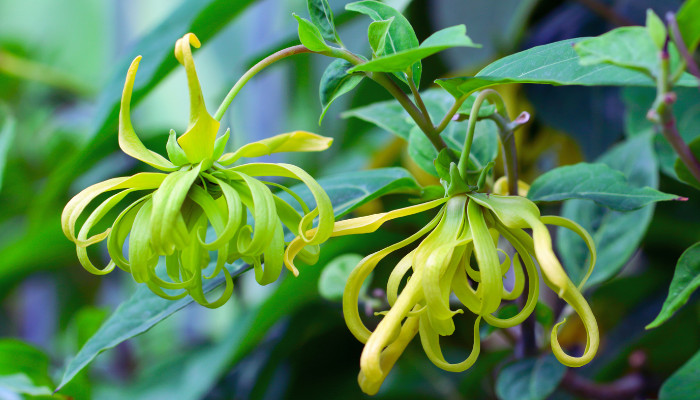
Illustrious History And Origin Of Ylang-Ylang
The well-documented, rich history of ylang-ylang dates back centuries. It is known for its very potent fragrance and plenty of beneficial properties from the ancient times when the South Asian rulers used these flowers to scent their palaces.
From religious occasions to weddings, ylang-ylang was widely associated with various events. It also offers numerous health benefits which was why the ancient Polynesians incorporated it into traditional medicine to treat diseases.
The royal and elite-class women used this flower to adorn their hair and clothing.
Like in Javanese and Malay royal courts, the fragrance of ylang-ylang was used extensively as they believed it aroused passion and desire.
Still today, Indonesian people spread these flowers on the beds of newlywed couples as this flower’s alluring warmth sets the perfect romantic ambiance!
This fragrant ylang-ylang extract was first distilled in Manila in 1860. A sailor named Albert Schwenger traveled the country, harvested the flowers, and then extracted the oil.
Later in the 19th century, it was introduced by the French settlers in most parts of the Indian Ocean and Pacific islands.
Nevertheless, in today’s world, the exotic sensuality and natural elegance of ylang-ylang make it a contemporary element for perfumers.
What Does Ylang-Ylang Smell Like?
Ylang Ylang unleashes a rich, exotic aroma with an earthy, fruity, sweet floral allure. It has a creamy, balsamic, honeyed nuance that gives a slightly intoxicating vibe of jasmine. The romantic floral notes also feature a powdery, custard-like smell, making it irresistibly unique.
Well, I think three words describe the aroma of ylang-ylang really well and those are sweet, floral, and exotic.
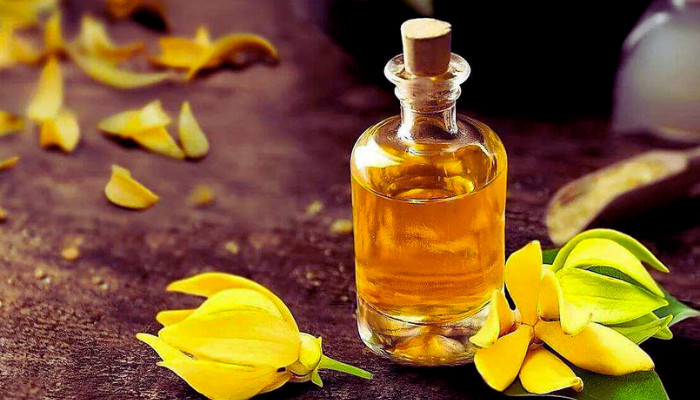
Interestingly, there is a subtle spicy tone to the aroma of ylang-ylang which makes it even more desirable in perfumery.
It’s very rich, potent, and has plenty of uses besides its use in the fragrance world.
Cultivation Factors That Influence the Smell of Ylang-Ylang
The first commercial cultivation of Ylang Ylang began in Manila in the 18th century. The people followed specific cultivating methods which are still in practice.
There are several factors that can alter the smell of ylang-ylang. So obtaining the highest quality essential oil requires meticulous attention to certain major factors including environment, soil condition, and so on.
So, here I’ll be highlighting some of the cultivating factors that can influence the smell of ylang-ylang:
- Suitable Region:
Ylang-ylang requires warm and humid conditions for growing. This flower thrives in tropical areas and grows well in countries like the Philippines, Indonesia, and Malaysia.
The vast majority around 80% of ylang-ylang comes from the island of Anjouan, in the country of Comoros, and the rest from Madagascar in Africa.
- Planting Methods:
The planting of ylang-ylang is also a complex process. For optimal growth of the tree, the right selection of healthy seedlings, proper germination, and providing rich nutrient soil with proper irrigation is a must.
- Harvesting Period:
The harvesting of the flower is also a meticulous task. It’s done in two stages where first it is hand plucked, removing the stems and leaves.
Later the flower is exposed and dried under the sun for a few hours before being sent to distillation.
- Processing and Final Transformation:
Before using ylang-ylang widely in perfumery, culinary, and medicines this flower goes under a single fractional distillation where it produces different versions of ylang-ylang essential oil that all smell different.
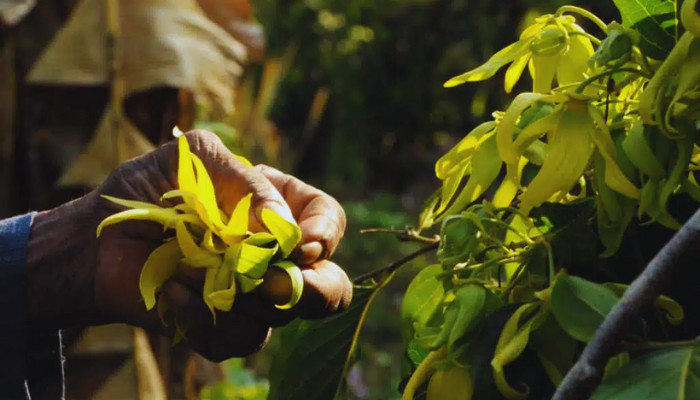
Variation of Ylang-Ylang Smell Depending on Extraction
Because ylang-ylang goes through stages of distillation, there are different grades of essential oil having distinct fragrance profiles.
So let’s explore the smell of all different types of ylang-ylang essential oil according to its extraction process:
| Types of Extract | Ylang Ylang Extra Grade A | Ylang Ylang I Grade B | Ylang Ylang II Grade C | Ylang Ylang III Grade D | Ylang Ylang Complete |
|---|---|---|---|---|---|
| Smell Variation | Most refined and complex aroma. It is the richest and most potent version. | Unleash an intensely sweet and green aroma. | Offers a strong, heavy, and spicy aroma. | It has an intense, sharp, and pungent aroma. | Authentic floral-fruity aroma and is considered closest to the original smell of ylang-ylang. |
| Collection Period | Collected after 30 min to 1 hour of distillation. | Distilled and collected after 3 hours. | Distilled and collected after 5 to 6 hours. | Collected after 7 to 8 hours during the third distillation process. | Goes through 10 to 15 hours of undisturbed distillation process before collecting the final product. |
| Usage | Used in aromatherapy and perfumery for its uplifting and calming effects. | Commonly used in making perfumes and hair care products. | Mostly used for making soaps, candles, and room sprays. | Used for making industrial products like detergents and cleaning agents. | This has a milder scent often used in making mild floral perfumes or soaps and skin care products. |
So, in simpler terms, the extra-grade ylang-ylang essential oil is the most fragrant, while the subsequent distillations are less intense but still have the same sweet and exotic scent.
These different grades of ylang-ylang essential oil vary in quality and potency, which is why they are usually sold at different price points and have different usability.
Well, that pretty much sums up what ylang-ylang essential oil smells like. Now, let’s hover to the next part!
What Are The Uses And Benefits Of Ylang-Ylang?
Now that you know all about the aroma and different grades of ylang-ylang essential oil, let me tell you its uses and benefits.
Ylang-ylang is very common in perfume and candle making, owing to its super strong aroma. However, it has a very rich history of use in traditional and therapeutic medicine!
Besides that, it is said to have plenty of skincare benefits, which led to its use in different cosmetic and skin care products.
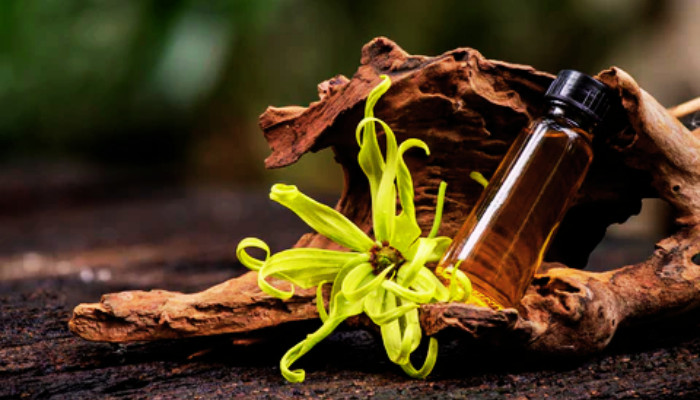
So, here I have included all the smell benefits of ylang-ylang to give you a clear idea:
Calming and Mood-Enhancing: Ylang-ylang is said to soothe the mind and promote relaxation. It has a calming effect on the nervous system, making it a popular ingredient in aromatherapy and relaxation techniques.
Improves Skin Health: The extracted oil of ylang-ylang is said to have antiseptic and anti-inflammatory properties, due to which it is a popular ingredient in skincare products. It can help to reduce skin irritation and redness and promote healthy skin.
Enhances Libido: Ylang-ylang is often used as an aphrodisiac due to its sensual aroma and ability to promote relaxation.
Control Blood Pressure: This soothing smell of ylang-ylang is believed to help regulate heart rate and blood pressure, making it beneficial for those with hypertension or high blood pressure.
Improve Respiratory Health: Due to its antiseptic properties, the ylang-ylang scent helps to clear the airways and promote healthy breathing.
Improves Hair Health: Ylang-ylang is known to promote healthy hair growth and strengthen the hair shaft, making it a popular ingredient in hair care products.
Why Ylang-Ylang Is Famous In Perfumery And Its Usage
Well, as you are perfectly aligned with ylang-ylang’s smell, benefits, and other important factors now you might be wondering what does ylang-ylang smells like in a perfume.
In modern times ylang-ylang-based perfumes are highly appreciated for their warm and sweet notes, which evoke a sense of exoticism and romance.
When sprayed on clothes it amazingly enhances a classy and elegant vibe in your outlook making you appealing to all. It is widely used by perfumers around the world to create more balanced and alluring floral scents.
Which Scents Pair Well With Ylang-Ylang
Ylang-ylang is a highly desirable aroma that lingers and captivates everyone around you. Whenever you are looking for an intense, fragrant floral experience, its symphonic balance of fruity-floral smell is worth exploring.
But have you ever wondered which scents pair well with this exotic essence?
If not then let me inform you that ylang-ylang often blends with other aromas flawlessly to create breathtaking fragrances.
For instance, in any summer scent’s opening, ylang-ylang mingles well with fresh notes like the smell of bergamot and lemon or other citruses. It adds a touch of brightness and gives you a refreshing sensation.
Ylang-ylang often pairs with the powdery, sweet smell of musk, vanilla, and amber in the base notes, bringing additional warmth and depth to the fragrance.
In men’s cologne, this yellow flower is combined with the woodsy smell of oud, cedar, or sandalwood creating a bold, masculine gentleman vibe in anyone’s look.
Lastly, if you love to wear floral fragrances you will see many high-end perfumes featuring ylang-ylang fusing with the sensual aroma of jasmine.
What Are Some Popular Fragrances With Ylang-Ylang?
Since you know all the details about ylang-ylang now, you must be wondering which fragrances include this useful ingredient in their notes profile.
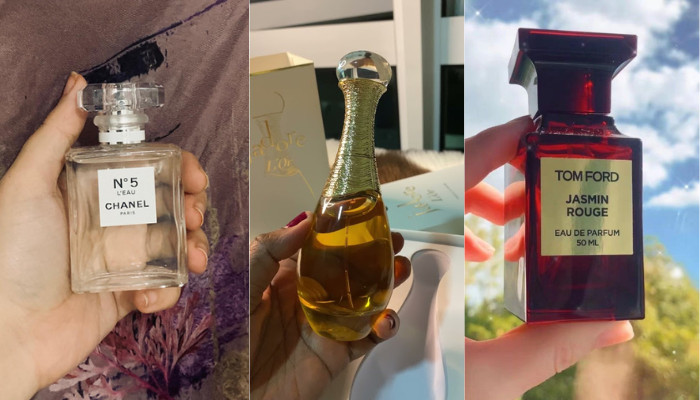
Well, to be honest, it’s a common note in perfumes, so you may not even know it yet own perfumes that have ylang-ylang in them.
So here are three of the most popular perfumes that include ylang-ylang as a part of their scent profile:
Chanel No. 5 By Chanel
The first perfume that features ylang-ylang is Chanel No. 5 by Chanel. This perfume by Jacques Polge is no less than a sensation and includes ylang-ylang in its opening notes.
So, right off the bottle, you can smell the pleasantly sweet floral tones of ylang-ylang in combination with aldehyde and other floral and spicy notes.
The ultimate blend is very classy and feminine, which led to this being one of the most iconic perfumes of all time.
The ylang-ylang plays out well and smooths the transition from the top notes to the heart of the scent, which again has plenty of floral notes.
It makes the fragrance smell much more elegant and luxurious. That’s why still many people look for similar perfumes that smell like Chanel No.5.
J’adore L’Or(2017) By Dior
J’Adore L’Or by Dior is another fragrance that has ylang-ylang in its scent composition. However, this time it’s at the heart of the fragrance rather than the beginning.
This perfume is a flanker to the famous J’Adore that opens with the aromatic scent of jasmine.
As it reaches the core, the fragrance gets very interesting and forms layers. That’s when you can detect the ylang-ylang, blending in seamlessly into the aroma.
It gives the perfume a very likable sweetness with its floral bloom, and it’s accompanied by different roses at the heart.
The perfume closes with the smell of tonka bean and warm vanilla, giving you a classic, elegant, and ultra-feminine aroma that is much enhanced by the ylang-ylang’s smell.
Jasmin Rouge By Tom Ford
Another perfume with ylang-ylang as one of its keynotes at the core of the scent is Jasmin Rouge by Tom Ford, created by Rodrigo Flores-Roux.
After a zesty and spicy opening, the perfume transitions into a floral center. There, you are greeted by the ever-sweet and exotic ylang-ylang that is accompanied by plenty of other floral notes like jasmine, sage, and neroli.
The ylang-ylang works beautifully in adding a sweet, floral aroma that works well with the spicy-citrusy notes.
Once it dries exotic flowers blend with the warm, comforting aroma of amber, vanilla, and labdanum to make it a sensual, mass-appealing fragrance.
Overall, this best-smelling Tom Ford perfume has a very luxurious and exotic aroma, enhanced by ylang-ylang’s alluring smell.
FAQs
Does ylang-ylang smell like jasmine?
Yes, both ylang-ylang and jasmine have deep, rich floral aromas that are slightly sweet and creamy.
What other essential oil can be mixed with ylang-ylang?
Ylang-ylang blends amazingly with various types of essential oils. Some of the most popular options that can enhance the flavor of ylang-ylang include lavender, jojoba, jasmine bergamot, and clary sage oil.
Can you put ylang-ylang oil directly on the face?
Yes, ylang-ylang oil can be applied independently on the skin to preserve youthfulness. But for the best result mix it well with the carrier oil to avoid any allergic reaction or irritation.
Is the ylang-ylang scent safe for cats and dogs?
No, the ylang-ylang scent could be toxic and poisonous for cats and dogs. The best thing is to avoid using fragrances or essential oils in your pet’s surroundings as they have extra sensitive olfactory senses.
Does ylang-ylang help you to sleep?
The sweet-smelling ylang-ylang oil has been proven to have a relaxing sedative effect that reduces stress and anxiety. It helps you to fall asleep faster and promotes sound sleep throughout the night.
Conclusion
In the upshot, the exotic essence of ylang-ylang is an excellent addition to the scent profile of any fragrance, especially if it’s floral and feminine.
Its sweet, floral, and slightly spicy aroma works wonders in adding depth and elegance to the aroma. Also, it seizes the attention of people and allows a sensory escape for anyone seeking a delightful olfactory journey.
That’s all for today, I hope that this article was useful for gaining detailed knowledge regarding ylang-ylang and its smell.
However, if you have any further queries comment below. Adios!
